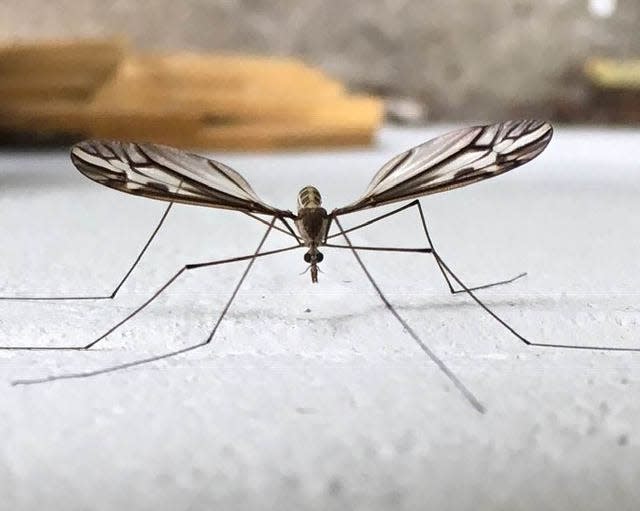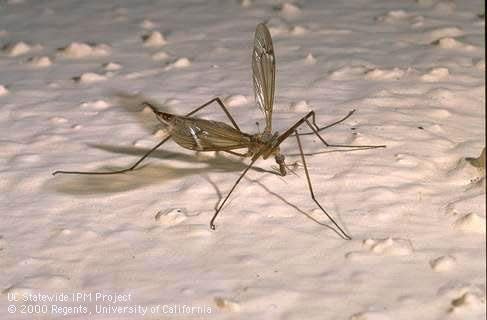Giant mosquito-like bugs are flying all over Phoenix right now. Here's what they are
Maybe you're wondering why so many huge mosquito-looking bugs are flitting around your yard and getting in your house right now.
Crane flies, also known as mosquito hawks thanks to their resemblance to giant mosquitoes, are out in force right now. They're characterized by their long, slender bodies and elongated legs, which give them a delicate appearance.
Don't panic. Crane flies are harmless insects that do not bite, sting or transmit diseases to humans or animals. They primarily feed on nectar.
Crane flies are common in Arizona and around the world. They like warmer temperatures and in Arizona they're most prevalent in late winter and early spring.
Here is everything you need to know about crane flies.
Do crane flies bite?
Crane flies do not bite. They are harmless and pose no threat to humans or animals. Unlike mosquitoes, crane flies do not have a feeding apparatus designed to puncture skin and draw blood.
“The adults do not have chewing mouthparts or a needle-like sucking mouth like a mosquito. The adult crane flies have reduced mouthparts. Some species feed on nectar, moisture, and many do not feed at all,” said Dawn Gouge, medical entomology professor at the University of Arizona.
It's insect season: All of the bugs that come out in spring in Arizona, from lady bugs to black widows
What do crane flies eat?
Crane flies consume plant juices and other organic matter. Their larvae feed on decaying vegetation and plant roots in soil.

Are there crane flies in Arizona?
Crane flies are commonly associated with temperate climates and moist habitats. Their presence in Arizona varies depending on local environmental conditions and habitat availability.
“We actually have dozens of species of crane flies that live in Arizona. Most of them live in springs and streams across the state, but some are able to survive in wet soil and overwatered lawns. Most of the crane fly adults that we see in our cities in Arizona come from lawns and wet soil in our city,” said Michael Bogan, associate professor at the School of Natural Resources and the Environment at the University of Arizona.
Why are crane flies everywhere?
Crane flies seem ubiquitous in metro Phoenix in springtime.
“They are abundant after particularly wet winters because the conditions are so favorable for their larvae that live in water or wet soil," Bogan said. "Over a series of dry years, crane fly larvae may grow slowly or not at all, instead of entering a dormant stage, so when we finally get a wet winter, they all can complete their life cycle and mature to the adult stage."

What are crane flies attracted to?
Crane flies are attracted to different things at different times in their life cycle.
Crane fly larvae are attracted to moist soil and decaying organic matter, such as leaf litter or compost, where they feed on plant roots.
Adult crane flies are primarily attracted to light sources, particularly artificial lights at night.
What do crane flies turn into?
Crane flies have four distinct life stages: egg, larva, pupa and adult.
“Crane fly adults that you see flying around are at the final stage of their life cycle," Bogan said. "They actually spend most of their lives as larvae in fresh water or wet mud and soil and their larval stage looks a little bit like a worm.”
The larval stage of crane flies, also known as leatherjackets, is aquatic or semiaquatic. They are typically found in moist soil, decaying vegetation or near bodies of water. They feed on plant roots and other organic matter.
After a period of growth and development, the larva pupates, forming a protective cocoon around itself. Inside this cocoon, the pupa transforms into an adult crane fly.
“They spend anywhere from a few months to a few years in that larval stage before they go through a pupation, like caterpillars, and emerge into the adult stage that flies around looking for mates. Their only job as an adult is to find mates and then lay eggs back in the water or wet soil where they came from,” said Bogan.
An adult crane fly is characterized by the familiar long legs and wings, which allow it to fly and mate. After mating, female crane flies lay eggs to restart the life cycle.
“The adults are all about mating and laying eggs, then they die. The immature stages are not often seen, remain below ground and feed on grass shoots and roots mainly, some decaying vegetation and even small invertebrates,” said Gouge.
What gets rid of crane flies?
Our experts said there's no reason to get rid of crane flies.
“For the most part, there's no need to try to get rid of crane flies. They don't bite or cause any damage and their season is very short and they'll be gone before you know it,” said Bogan.
“Why do you want to get rid of them? If you avoid planting grass, you will have fewer in your house; overwatered lawns generate higher numbers," Gouge said.
"However, you could also close curtains, shutters and doors after dark to keep them out of the home. If they do flutter indoors, they can be relocated gently outside or vacuumed up. If left alone, they will naturally die within days. They are absolutely harmless."
Here are some ways to get rid of crane flies if you're absolutely determined to:
Reduce moisture: Crane flies are attracted to moisture, so minimizing it can help discourage them.
Turn off outdoor lights: Turn off unnecessary outdoor lights at night or use yellow or amber bulbs that are less attractive to insects.
Seal entry points: Seal cracks and gaps in doors, windows and screens to prevent crane flies from entering your home.
Remove breeding sites: Eliminate standing water, moist soil and decaying vegetation where crane fly larvae thrive. This could involve clearing clogged gutters, removing debris and improving drainage.
Use insecticides with care: In severe infestations, insecticides labeled for crane fly control can be used. Follow the instructions carefully and consider using insecticides with lower environmental impact, such as those containing natural ingredients or targeting specific life stages of the crane fly.
Seek professional help: If crane fly infestations persist or if you're dealing with a large population, consult a pest control professional who can assess the situation and recommend appropriate measures.
How do you prevent crane flies?
“It's hard to prevent crane flies since they're really reacting to the rainy weather, which is not preventable either. If you have a grass lawn, you can reduce the number of crane flies by ensuring you're not overwatering your lawn,” said Bogan.
Here are ways to prevent crane flies by making your less favorable for their development:
Use less outdoor lighting.
Keep your yard well-maintained by regularly mowing the grass, removing debris and trimming vegetation. This can help reduce breeding sites.
Eliminate or reduce areas of standing water, such as in bird baths, clogged gutters or containers. These areas are breeding grounds for crane flies.
Aerating your lawn can help improve soil drainage and reduce moisture levels, making it less hospitable for crane fly larvae.
What is a homemade crane fly repellent?
There's no specific homemade repellent for crane flies.
“There isn't any really effective crane fly repellent. During the warm daytime temperatures, crane flies are often looking for a cooler, darker place to be, which might be inside your house,” said Bogan.
Like many insects, they can also be attracted to light so ensuring you don't have bright lights on around your house or that you close the door quickly when you go outside at night, can help reduce the number of crane flies attracted to your house.”
Gouge also pointed to outdoor lighting as a way to deter crane flies.
“Using LED or other low UV emitting lights outside your home would fail to attract them,” said Gouge.
Should I worry about crane flies?
Crane flies “are harmless to humans and other animals. They are recyclers to some degree and food for birds, fish, reptiles and amphibians,” said Gouge.
They do not bite, sting or transmit diseases and they do not cause damage to structures or plants.
Black widows in Phoenix Everything to know about these arachnids
Are crane flies harmful to dogs?
Crane flies are not harmful to dogs. They do not bite or transmit diseases.
“In fact, many dogs seem to have fun chasing them and trying to bite or eat them,” said Bogan.
What is the difference between a mosquito hawk and a crane fly?
"Mosquito hawk" is a colloquial term often used to refer to crane flies because of their similar appearance.
“Just two different common names for the same type of insect,” said Bogan.
Can a mosquito hawk sting you?
Mosquito hawks, also known as crane flies, do not sting or bite people.
Do mosquito hawks eat mosquitoes?
“No, unfortunately, they do not," Bogan said. "But lots of other native insects do, such as dragonflies, so maintaining a vibrant ecosystem with native predators is an important strategy for reducing mosquitoes.”
Do crane flies eat mosquitoes?
Crane flies do not eat mosquitoes. They do play a role in plant pollination, though.
Got a story you want to share? Reach out at [email protected]. Follow @tiffsario on Instagram.
Support local journalism and subscribe to azcentral.com.
This article originally appeared on Arizona Republic: Crane flies: Why you have so many and how to get rid of them
